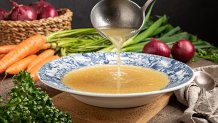In the wake of the rise of violence toward members of the AAPI community, NBCLX is looking at the common bonds that tie us together - in this case specifically the love of food and the distinctly unique stories they tell.
Every culture has a unique connection to a particular food or cuisine and most have their own variants of meat or bone-based soups. But the tradition of laboriously simmering broth of undesirable animal scraps to slowly extract life-giving nourishment is a tradition that is quintessentially Asian.

Casto Unson, founder/owner of Tita’s Delivery Service, a catering company serving traditional Filipino cuisine, says the practice of boiling bones to “[stretch] the meal when the budget is tight” is distinctly Asian. Other cultures’ soups that use, for instance, “the whole chicken [is] not coming from the same necessity,” says Unson. In fact, bone broth has been used for over 2,500 years in Chinese Medicine. In addition to being the base to many Eastern dishes, such as pho, ramen, or sinigang (a Filipino soup or stew characterized by its sour and savory taste), it is typically considered the antidote to the common cold in Asian households and widely enjoyed in communal settings.
Esteemed top chef contestant and owner of Maui restaurant Tin Roof, Sheldon Simeon remarks that “for a lot of us, bone broth was the first thing we had.” For instance, Simeon says his children never had pureed foods as babies. “It was rice and soup.”

Like many other Asian-Americans, Unson takes comfort in bone broth that has been laboriously simmered for hours. More specifically, he favors lomi, a noodle soup his mother typically makes using pork necks. In the true labor-of-love form, his mother boils the bones until meat is tender to the point of falling off the bone. She then painstakingly separates the meat from the bones piece by piece, while gingerly ladling broth, seasoned with onion, garlic, fish sauce into a bowl of noodles topped with Chinese cabbage.
“It’s very nourishing,” Unson said. “I just got my second vaccination shot and [my mom made it for me] just in case [I experience side effects].” It’s an elixir enjoyed with the entire family, and in true Asian-American form, these broths center liquid gold patiently brewed from “undesirable” parts.
More From NBCLX
Taking a Flight Soon? Here's What to Expect
How a Miami-Based Hair Care Company is Changing the Self-Care Game
Unson also recalls less pleasant food memories. More specifically, he remembers the quintessential Asian-American lunchbox experience of bringing lunch to school and getting weird looks. “It was kind of smelly. I got some weird looks. At that time, most of my friends were white, so I did feel othered.”
Today, Unson has explored multiple facets of the food industry over a long career. He's attended culinary school, studied food science, and served as a cooking instructor. Now, he introduces Filipino food to new audiences as a way of normalizing the cuisine so that it is not “stinky food nobody wants to try.”

His success is mirrored in that of bone broth which has become trendy and has reached a level of commercial success. In 2019, the bone broth market surpassed 2.6 billion in the United States and is only expected to grow over the next several years. Marketed as a healthy alternative and well received by celebrities such as Kylie Jenner, keto enthusiasts and paleo dieters alike, bone broth can be found in takeaway cups for $5-to-$12 in trendy eateries and grocery stores. These products typically boast claims of containing collagen, which typically is extracted from animal parts such as chicken feet, pork snout, trotters, and necks.
It is unsurprising that the process of extracting collagen into broth is a process foreign to many consumers. “It's a very modern Western problem of not being connected to the process of food,” Unson remarked. “For instance, seeing meat in a butcher's case in Styrofoam with plastic wrap. You don't see the whole animal or even [the] fish.” But in Asian Markets, animal parts and whole animals are often seen on display. While you might not see a pig in its entirety in an H-Mart, “there's still that stronger connection to the process and the art of the food.” Similarly, commercially sold and individually packaged broth sold in coffee cups sharply contrasts the communal experience of sharing homemade bone broth over a table with loved ones.
However, presentation is not the only way commercial and traditional bone broth diverge. One of the largest challenges in commercial bone broth is the presence of flavoring agents deemed by some as harmful. Unson explains that “in the food manufacturing industry, time is money.” The process of painstakingly brewing collagen out of bones and joints is not conducive to energy efficiency, which incentivizes commercial bone broth to utilize flavoring agents readily available from the food industry.
The problem with food trends is that it is a double-edged sword. On one hand, when something Asian becomes trendy and introduced to a larger market, while it might not be the most authentic – it is still a form of broader recognition. “We’re getting more recognition and we’re reading a wider audience,” says Unson. But it’s also bittersweet, because “at the end of the day, [companies could be] capitalizing on a tradition that isn’t theirs,” which begs the question of who is allowed to make what kinds of food.
For Simeon, who was born and raised in Hawaii, the question is less about who, but how. Simeon says that communities in Hawaii can be an example to the rest of the country for celebrating individual cultures. Despite being Filipino, he regularly pounds Japanese mochi and celebrates Chinese New Year, but he does so with great respect to each respective tradition. In the same way that raw fish on rice does not automatically become poke without due care or proper seasoning, any culinary tradition needs to be respected “in the highest level,” Simeon says. For Simeon, authenticity means being mindful of where the respective culinary tradition comes from, but also the creativity that inspires it.
In practice, this looks a lot like not mimicking his cooking to other cuisines. It is liberally using the “heavier flavors of fish sauce and . . . chilis.” Laughingly, Simeon explains that his Hawaiian lunchbox experiences is one where eating dried fish in school is accepted. “Bento [boxes with kimchi] for lunch was normal, and I’m very thankful for that.”
On a day off, Simeon finds himself making Lauya, a ginger-forward bone broth consisting of either pork or beef bones, shank or ribs. Simmered for over eight hours notes of bay leaf, sweet potato, and fish sauce, his philosophy is deceptively simple. Rather than cooking to cater specifically to any demographic or palette, he stays rooted to his upbringing. Or in his words, “when I cook, I’m just thinking about cooking delicious food.”


